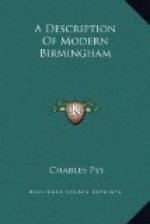The church is a vicarage, dedicated to St. Matthew, or All Saints: it is an ancient pile of building, singular in its appearance, being in the form of a cross, the transept of which is composed by large side chapels, whose roofs lie east and west, parallel to the body of the church. The tower, which is situated at the south-west angle of the west front, is strong, plain, and far from inelegant, being built with coarse lime stone, on which a new spire was erected since 1775, when a set of eight musical bells were fixed there, by Mr. Rudhall, of Glocester; the weight of the tenor being more than twenty-three hundred, and the key note E flat.
The following inscriptions are round the bells:—
1. “When us you ring, we’ll sweetly sing.”
2. “Fear God, honour the king.”
3. “Prosperity to the parish.”
4. ditto ditto.
5. “The Rev. John Darwall, vicar.”
6. “Thomas Rudhall, Glocester, founder.”
7. “Thomas Hector, Edward Licet, Thomas Overton, Deykin Hemming, church-wardens.”
8. “I to the church the living call, And to the grave do summon all.”
The font of this church is alabaster, of an octagon form, with shields, richly sculptured.
On each side of the chancel are eleven stalls, very entire, the seats of which, being lifted up, exhibit a series of grotesque figures, curiously carved, in bas relief; no two of which resemble each other. Over the communion table is a large painting, representing the last supper.—The vicarage, where the Rev. Philip Pratt resides, is in a delightful situation, being on an eminence, and encompassed with lofty and majestic trees.
There are three fairs in the year, viz. February 24th, Tuesday in the whitsun week, and the Tuesday before St. Michael; at which time the races take place, and have been for a number of years both numerously and genteely attended; as a proof of it, the inhabitants in the year 1809 expended the sum of thirteen hundred pounds in the erection of a grand stand; in the lower apartments of which is a billiard table, where they resort for recreation. The fair at whitsuntide is not held by charter, but being market day, at that holiday time is considered a fair by prescription. There is in this town a charity school for twenty-four boys and sixteen girls, who are all cloathed in blue: they are instructed and cloathed gratis, but neither lodged nor boarded. The expenses attending this school are defrayed by subscriptions, donations, and sermons preached on the wake Sunday, which is the Sunday before St. Michael. The school-room is near the George hotel. There is also a free grammar school, near the church, founded by Queen Mary, in the first year of her reign, which she endowed with certain lands that are vested in trustees. The High-street is spacious, and therein are some respectable shops, and a conduit for the use of the inhabitants.—Park-street is also a wide one, but there are numerous low houses in it.




